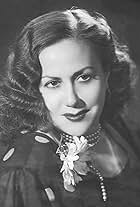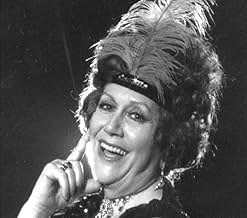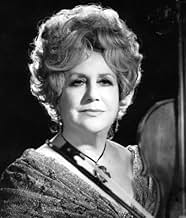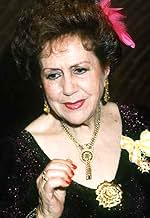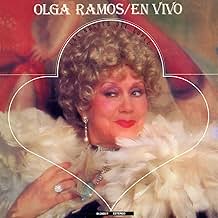Olga Ramos(1918-2005)
- Actress
- Soundtrack
Olga Ramos was a popular singer, violinist and actress who seldom appeared in films but was much in demand on stage, television and recordings. She started playing the violin at age eight and by the time she reached adulthood she had graduated with honors from the Royal Conservatory of Madrid obtaining a Master of Music for her virtuosity on that instrument. She also took drama and voice lessons on a side since the times required versatility if you needed to earn a living. One of her professors was the famed pianist and conductor Ataulfo Argenta who encouraged her to both sing and play the violin.
Her professional career had a slow start due to the outbreak of the Spanish Civil War and its devastation which marked the postwar years. Young Olga struggled trying to find employment as a musician. However Spain was slowing rebounding and different forms of entertainment were emerging. One of them was the film industry and young Olga was hired to play a singing gypsy in the film "Leyenda rota" (1940). Her next assignment came thanks to a government mandate that required live entertainment in all movie houses. At the Bilbao Cinema, the house orchestra needed a violinist and Olga got the job.
Soon, she built up a reputation as an excellent soloist and started receiving requests to play with bands entertaining at cafe concerts. Those establishments were a combination bar-cafeteria-restaurant and were fast becoming the rage since they offered customers food, drinks, and live music, all for an affordable price. Most important for musicians, cafe concerts were popping up all over Spain, providing endless employment opportunities. In time, Olga Ramos turned into one of the most popular attractions for the cafe concert crowd. At first she just played with the anonymous house bands but when her popularity grew, she formed her own band with the help of fellow musician Enrique Martinez de Gamboa, a.k.a. "El Cipri", whom she ended up marrying. The couple were a perfect meeting of the minds and talents. "El Cipri" not only played sax, clarinet and accordion, but was also a talented arranger, poet and composer. Together they raised the music quality of the cafe concert to new heights.
With "El Cipri" arrangements, Olga and her band could now include in their repertoire of Spanish standards, arias and excerpts from operas and zarzuelas, as well as music from Hollywood films and Broadway musicals. Encouraged by her husband, Olga often sang during their show and the audiences were enthralled by her voice and personal singing style. She became known as "the queen of the cafe concerts" and always lived up to her fame. Throughout the late 1940s and early 1950s, they played constantly all over Spain and about this time Olga was asked to record her first sides as a vocalist. However times were changing, and with the arrival of television, the glorious days of cafe concerts were over. "El Cipri", who was much older than Olga decided to retire and supervise personally the education of their only daughter, Olga Maria.
Olga took a year's sabbatical during which she concentrated on her duties as housewife and mother but music was too strong a force inside her. She decided to continued her career and unstintingly turned to singing. Olga had always sang and enjoyed the "cuples" or pop songs from the beginning of the XX Century and noticed that those same songs were becoming popular again. Among other factors, this was due to the immense box office success of the film "El ultimo cuple" (1957) which unleashed a veritable "cuplemania" on the public of Spain and Latin America. The old "cuples" invaded everything; films, radio, television, stage as well as the recording industry. Olga revamped her repertoire accordingly and devised a nostalgic one woman show in which she sang, did comedy routines, and, as sort of intermission, played the violin. This new approach was well received by audiences and critics alike who reported that Miss Ramos was creating a new way to deliver the popular "cuples".
In 1967, Romanian expatriate and businessman Alexander Carven understood Olga's potential and made her an offer she could not resist. He had a restaurant in the old section of Madrid and wanted to turn it into a showplace for Olga Ramos. She accepted immediately since this would give her the opportunity to work close to home. Olga became Carvens business partner and together they remodeled the restaurant converting it into a dinner-theater they named "El ultimo cuple". Later, after its continued success, it was renamed "Noches de cuples" (Nights of cuples).
With Olga's extraordinary performances and serving exquisite Spanish cuisine, the place became a stalwart of the Madrid night scene for over fifteen years. Royalty, politicians, writers, journalists, show business personalities, celebrities of all sorts, along with local residents and tourists, visited Olga's place and made it their favorite. Olga was also highly acclaimed as a recording personality. She recorded several studio albums that were very successful, and a live album of her show which earned her a gold record and has been re-released several times. She also appeared on television quite often in the best variety shows. In short, "the queen of cafe concerts" had reinvented herself as "the queen of the cuples", the "cupletista" (cuple vocalist) par excellence.
At home, it became obvious that her daughter Olga Maria wanted to follow in her mother's footsteps. Olga arranged for her to have music and voice lessons as she had done, and personally groomed her for the big time. Olga Maria made her debut at Olga's place and went on to achieve her own stage and recording career. The media and the public has always considered Olga Maria her mother's qualified successor.
When Mr. Carven passed away, Olga Ramos became the sole owner of the dinner theater and remained so for a few more years, however trouble was brewing at City Hall. Neither Olga nor Olga Maria were given satisfactory explanations, but it seems Olga's place was in the way of some big city developments and the celebrated establishment was ordered to close and be demolished. Olga and her daughter tried to stop it, but after spending a small fortune in legal and attorney's fees, they gave up the fight. Heartbroken, the famed artist continued recording and guest starring on television, often as a duo with her daughter.
On the more positive side, Olga Ramos received many tributes and accolades from her peers and from community organizations. Ironically, the city of Madrid placed a commemorative plaque with her name on the street where her dinner theater used to be. The city of Badajoz, her birth place, named a street after her, while Spain's Ministry of Labor awarded her their Medal of Merit for her long uninterrupted career. By age 80, Olga's health began failing but she would not consider retirement. She would say to the press with a wink "I might have wrinkles on my face but not on my voice". However she began spending more time resting at her magnificent country villa on the outskirts of Madrid. It was there on August 25, 2005 that her heart succumbed to cardiac arrest ending up the life of one of Spain's brightest performers.
Her professional career had a slow start due to the outbreak of the Spanish Civil War and its devastation which marked the postwar years. Young Olga struggled trying to find employment as a musician. However Spain was slowing rebounding and different forms of entertainment were emerging. One of them was the film industry and young Olga was hired to play a singing gypsy in the film "Leyenda rota" (1940). Her next assignment came thanks to a government mandate that required live entertainment in all movie houses. At the Bilbao Cinema, the house orchestra needed a violinist and Olga got the job.
Soon, she built up a reputation as an excellent soloist and started receiving requests to play with bands entertaining at cafe concerts. Those establishments were a combination bar-cafeteria-restaurant and were fast becoming the rage since they offered customers food, drinks, and live music, all for an affordable price. Most important for musicians, cafe concerts were popping up all over Spain, providing endless employment opportunities. In time, Olga Ramos turned into one of the most popular attractions for the cafe concert crowd. At first she just played with the anonymous house bands but when her popularity grew, she formed her own band with the help of fellow musician Enrique Martinez de Gamboa, a.k.a. "El Cipri", whom she ended up marrying. The couple were a perfect meeting of the minds and talents. "El Cipri" not only played sax, clarinet and accordion, but was also a talented arranger, poet and composer. Together they raised the music quality of the cafe concert to new heights.
With "El Cipri" arrangements, Olga and her band could now include in their repertoire of Spanish standards, arias and excerpts from operas and zarzuelas, as well as music from Hollywood films and Broadway musicals. Encouraged by her husband, Olga often sang during their show and the audiences were enthralled by her voice and personal singing style. She became known as "the queen of the cafe concerts" and always lived up to her fame. Throughout the late 1940s and early 1950s, they played constantly all over Spain and about this time Olga was asked to record her first sides as a vocalist. However times were changing, and with the arrival of television, the glorious days of cafe concerts were over. "El Cipri", who was much older than Olga decided to retire and supervise personally the education of their only daughter, Olga Maria.
Olga took a year's sabbatical during which she concentrated on her duties as housewife and mother but music was too strong a force inside her. She decided to continued her career and unstintingly turned to singing. Olga had always sang and enjoyed the "cuples" or pop songs from the beginning of the XX Century and noticed that those same songs were becoming popular again. Among other factors, this was due to the immense box office success of the film "El ultimo cuple" (1957) which unleashed a veritable "cuplemania" on the public of Spain and Latin America. The old "cuples" invaded everything; films, radio, television, stage as well as the recording industry. Olga revamped her repertoire accordingly and devised a nostalgic one woman show in which she sang, did comedy routines, and, as sort of intermission, played the violin. This new approach was well received by audiences and critics alike who reported that Miss Ramos was creating a new way to deliver the popular "cuples".
In 1967, Romanian expatriate and businessman Alexander Carven understood Olga's potential and made her an offer she could not resist. He had a restaurant in the old section of Madrid and wanted to turn it into a showplace for Olga Ramos. She accepted immediately since this would give her the opportunity to work close to home. Olga became Carvens business partner and together they remodeled the restaurant converting it into a dinner-theater they named "El ultimo cuple". Later, after its continued success, it was renamed "Noches de cuples" (Nights of cuples).
With Olga's extraordinary performances and serving exquisite Spanish cuisine, the place became a stalwart of the Madrid night scene for over fifteen years. Royalty, politicians, writers, journalists, show business personalities, celebrities of all sorts, along with local residents and tourists, visited Olga's place and made it their favorite. Olga was also highly acclaimed as a recording personality. She recorded several studio albums that were very successful, and a live album of her show which earned her a gold record and has been re-released several times. She also appeared on television quite often in the best variety shows. In short, "the queen of cafe concerts" had reinvented herself as "the queen of the cuples", the "cupletista" (cuple vocalist) par excellence.
At home, it became obvious that her daughter Olga Maria wanted to follow in her mother's footsteps. Olga arranged for her to have music and voice lessons as she had done, and personally groomed her for the big time. Olga Maria made her debut at Olga's place and went on to achieve her own stage and recording career. The media and the public has always considered Olga Maria her mother's qualified successor.
When Mr. Carven passed away, Olga Ramos became the sole owner of the dinner theater and remained so for a few more years, however trouble was brewing at City Hall. Neither Olga nor Olga Maria were given satisfactory explanations, but it seems Olga's place was in the way of some big city developments and the celebrated establishment was ordered to close and be demolished. Olga and her daughter tried to stop it, but after spending a small fortune in legal and attorney's fees, they gave up the fight. Heartbroken, the famed artist continued recording and guest starring on television, often as a duo with her daughter.
On the more positive side, Olga Ramos received many tributes and accolades from her peers and from community organizations. Ironically, the city of Madrid placed a commemorative plaque with her name on the street where her dinner theater used to be. The city of Badajoz, her birth place, named a street after her, while Spain's Ministry of Labor awarded her their Medal of Merit for her long uninterrupted career. By age 80, Olga's health began failing but she would not consider retirement. She would say to the press with a wink "I might have wrinkles on my face but not on my voice". However she began spending more time resting at her magnificent country villa on the outskirts of Madrid. It was there on August 25, 2005 that her heart succumbed to cardiac arrest ending up the life of one of Spain's brightest performers.
